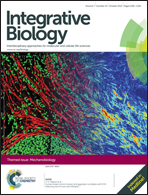Regulation of epithelial cell organization by tuning cell–substrate adhesion†
Abstract
Collective migration of cells is of fundamental importance for a number of biological functions such as tissue development and regeneration, wound healing and cancer metastasis. The movement of cell groups consisting of multiple cells connected by cell–cell junctions depends on both extracellular and intercellular contacts. Epithelial cell assemblies are thus regulated by a cross-talk between cell–substrate and cell–cell interactions. Here, we investigated the onset of collective migration in groups of cells as they expand from a few cells into large colonies as a function of extracellular matrix (ECM) protein coating. By varying the amount of ECM presented to the cells, we observe that the mode of colony expansion, as well as their overall geometry, is strongly dependent on substrate adhesiveness. On high ECM protein coated surfaces, cells at the edges of the colonies are well spread exhibiting large outward-pointing protrusive activity, whereas cellular colonies display more circular and convex shapes on less adhesive surfaces. Actin structures at the edge of the colonies also show different organizations with the formation of lamellipodial structures on highly adhesive surfaces and a pluricellular actin cable on less adhesive ones. The analysis of traction forces and cell velocities within the cellular assemblies confirm these results. By increasing ECM protein density, cells exert higher traction forces together with a higher outward motility at the edges. Furthermore, tuning cell–cell adhesion of epithelial cells modified the mode of expansion of the colonies. Finally, we used a recently developed computational model to recapitulate the emergent experimental behaviors of expanding cell colonies and extract that the main effect of the different cell–substrate interactions is on the ability of edge cells to form outward lamellipodia-driven motility. Overall, our data suggest that switching behaviors of epithelial cell assemblies result in a tug-of-war between friction forces at the cell–substrate interface and cell–cell interactions.

- This article is part of the themed collection: Mechanobiology


 Please wait while we load your content...
Please wait while we load your content...